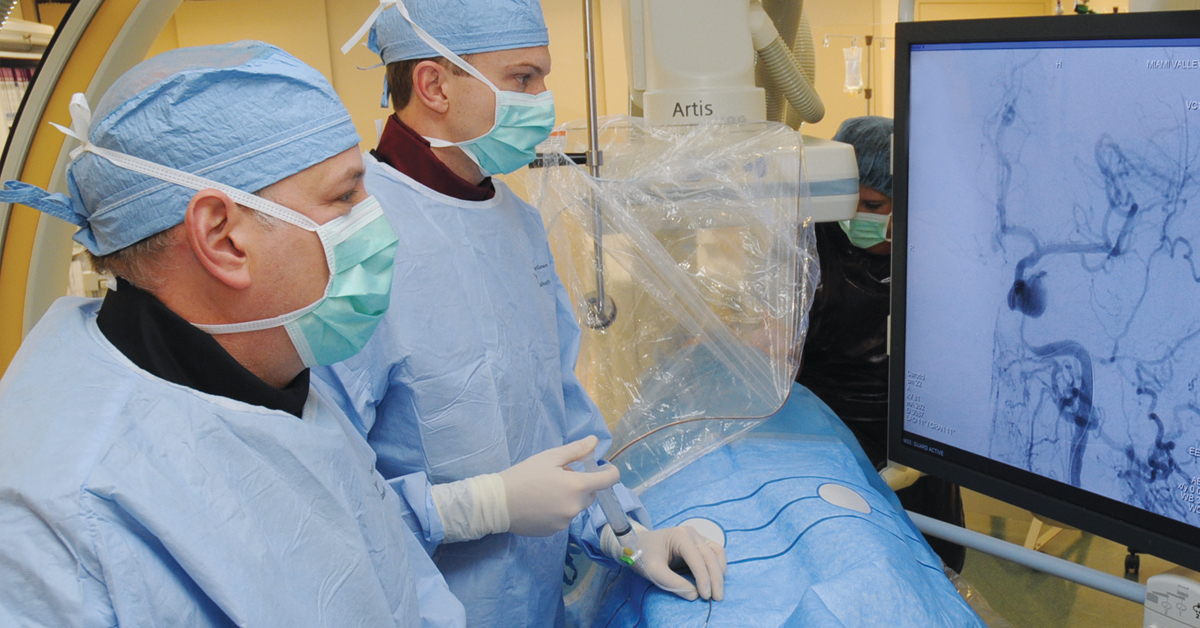Will My Brain Aneurysm Burst?

Answer a few questions and we'll provide you with a list of primary care providers that best fit your needs.
Knowing you have a brain aneurysm is stressful. If it ruptures, the internal bleeding may cause a stroke or even death. Although many aneurysms never rupture, it’s important to take any symptoms seriously.
Discovering You Have an Aneurysm
If you complain of double vision, headaches, pain behind your eyes, or partial paralysis of your face, your doctor likely will test for a brain aneurysm. Sometimes aneurysms are discovered when doctors are running tests for another condition.
“When aneurysms are small and not pushing on the brain or nerves, you may not have any symptoms,” says Bryan Ludwig, MD, with the Clinical Neuroscience Institute. “We find the aneurysm when we’re examining the patient for other reasons, so the news is a complete surprise,” he says.
If you have multiple risk factors that make you more likely to have a brain aneurysm, your doctor may want to screen for one. “Family history, especially if a first-degree relative had a ruptured aneurysm, would be a reason to check,” Dr. Ludwig explains. Other risk factors are high blood pressure, smoking, drug abuse, and advancing age.
“Ruptured aneurysms near the brain can cause the worst headache in your life,” says Dr. Ludwig. “But with an unruptured aneurysm, you may not have a headache at all. It’s a big distinction.”
Treating an Unruptured Brain Aneurysm
“We have two different paths we can follow for a patient who has an aneurysm that hasn’t burst,” explains Dr. Ludwig.
- Wait and watch. If your aneurysm is in a very low risk category (it’s small, not growing and you don’t smoke, have high blood pressure or family history), it is unlikely to cause future problems. “We’ll watch it to make sure it isn’t growing, but statistics show that many small aneurysms don’t need to be treated. You can live your entire life with one and never have an issue,” Dr. Ludwig says.
- Surgery to repair the brain aneurysm. If the aneurysm is large, in a dangerous location, or doctors believe the risk of rupture is significant, surgery is typically recommended. The most common surgery, according to Dr. Ludwig, locates and repairs the bulge by going through an artery in the leg or arm. “Surgery blocks the blood flow to the aneurysm,” he says. “The surgery requires only a one-day hospital stay and many patients return to work within three days with one very small incision to show for it.”
Less common is a surgical treatment for brain aneurysms that requires opening the skull and making the repair. “Both procedures are still done; it just depends on specific characteristics of the aneurysm as to which surgery would be best,” says Dr. Ludwig.
Thanks to technology that “evolves at light speed” Dr. Ludwig says surgeries increasingly are becoming easier and safer. “We started using one new device, a pre-shaped intra-aneurysmal mesh, as soon as the FDA approved it. We were the first in Dayton to use it.”
Living With a Brain Aneurysm
Any aneurysm has the potential to rupture, and Dr. Ludwig knows that living with that knowledge is difficult. “It creates a lot of anxiety and stress in some folks,” he says. “That’s why many patients opt for surgery to repair their aneurysm even when the risks of a rupture is very low. They’d rather get it over with and not worry about it anymore.”
“When a patient is newly diagnosed, I spend quite a bit of time with them reviewing their options and walking them through the statistics,” says Dr. Ludwig. “Some patients say they’ll just live with their aneurysm. Others want the peace of mind that their aneurysm was treated.”
Don’t Believe the Myths
Dr. Ludwig cautions his patients not to believe two common myths about aneurysms.
“One is that people have brain aneurysms from birth. That’s not generally the case. Aneurysms develop over a lifetime,” he says. “Another is that an aneurysm can disappear or heal itself. This is very rare and only happens in aneurysms that are considered benign because the flow of blood is so slow it eventually forms a clot and seals off the bulge.”
To learn more about caring for aneurysms, talk to your doctor or health care provider or search for a provider.
Answer a few questions and we'll provide you with a list of primary care providers that best fit your needs.
Bryan Ludwig MD, Clinical Neuroscience Institute; National Institute of Neurological Disorders and Stroke; National Heart, Lung, and Blood Institute





